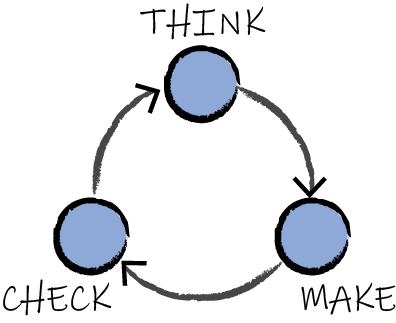Chapter 21. Checks (and Balances)
[ 21 ]
Checks (and Balances)
I left this chapter for last. I almost didn’t finish it. I spent all my time and energy thinking and making the rest of the book, and now I don’t have the proper amount of time to give this chapter its due.
How ironic that this mirrors real life. You spend your time thinking about stuff and making stuff and spend much less time checking stuff.
If you survey the literature—or even flip through this book—the bulk of the job is thinking about stuff and making stuff. But remember the model: Think-Make-Check (Figure 21-1). Check is just as important as Think and Make. And the model is a cycle. You Think so you know what to Make. You Make so have something to Check. You Check so you get feedback to Think about. Think-Make-Check creates a virtuous cycle where Check provides fuel to Think about and Make better things.

Figure 21-1
Think-Make-Check create a virtuous cycle where each iteration teaches you more and more about the product and its users
Thinking and making vary more than checking. How you Think about users differs from how you Think about interactions. How you Make interactions differs from how you Make interfaces. In contrast, you always Check everything the same way. Checks follow the same pattern regardless of what you want to Check.
In this chapter, you’ll learn how to receive and manage feedback, how ...
Get Collaborative Product Design now with the O’Reilly learning platform.
O’Reilly members experience books, live events, courses curated by job role, and more from O’Reilly and nearly 200 top publishers.

